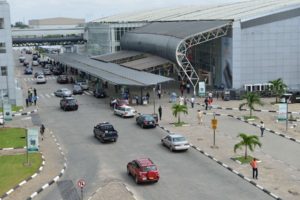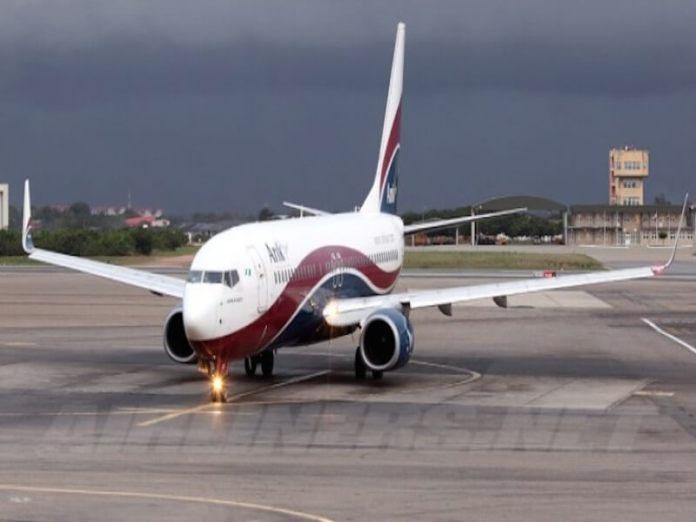
Last week reports indicated that Arik Air aircraft parked at the ramp of the domestic terminal of Lagos airport was accessed and critical equipment removed. Chinedu Eze looks at the security apparatus of the airport, insider security threats, and what concerned authorities are doing to forestall such incidents from happening again
Many Nigerians were shocked when the report went virile on social media that Arik Air’s leased aircraft, a Boeing 737-700 with registration number, EI-ULN parked at the ramp of the Murtala Muhammed Domestic Airport (MMA2) was tampered with and critical equipment removed by persons initially suspected to have breached security and accessed the airside of the airport.
But the latest investigations lean on the fact that what happened might have been an insider job, which the aviation industry refers to as an insider threat.
What was taken from the aircraft were Flight Management System (FMS), Pilot Static Cover, and other sensitive aircraft parts.
A flight management system is a fundamental component of a modern airliner’s avionics. An FMS is a specialised computer system that automates a wide variety of in-flight tasks, reducing the workload on the flight crew to the point that modern civilian aircraft no longer carry flight engineers or navigators.
As it is now, it has not been confirmed whether the parts were taken away as stolen or were taken away to damage the aircraft so that it would not fly again. Industry observers said it might be the latter because aircraft parts are not like vehicle parts, which can be bought in the open market. Every aircraft part has a date and usage profile so the aircraft was forced into AOG (aircraft on ground) by the theft and hence the suspicion of sabotage.
Investigation
THISDAY learnt that immediately after the incident, the Aviation Security of the Federal Airports Authority of Nigeria (FAAN) in collaboration with the management of MMA2, Bi-Courtney Aviation Services Limited (BASL) set up a body to investigate what happened.
The investigation team found that Arik Air Chief Security Officer (SCO) reported the incident to FAAN in the mid-day of January 20, 2022, and explained that the Arik Air aircraft with registration number EI-ULN was parked at MMA2 ramp at 4:30 pm the previous day.
The report stated that on commencement of operation the following day at 6:10am, the pilot in chief, Captain James Johan Lowhoy noticed that the aircraft had been tampered with, as the door was found open and following checks it was revealed that the aircraft FMS had been removed.

The source also disclosed that the Arik Air aircraft engineer in charge of the aircraft said that at about 4:30 pm on January 19, after the pilot and cabin crew had left the aircraft, the engineers carried out routine checks on the aircraft, which lasted for about one and half hours and when they left, the aircraft was still parked at the apron.
THISDAY also gathered that the aircraft engineers were still at the engineering room when the Arik Air catering personnel came to them at about 8:40 pm and informed them that they wanted to service the aircraft.
“One of the aircraft engineers went with the catering personnel who serviced the airplane, which took about 10 minutes. When the catering personnel left, the engineer closed the airplane and did not go back to the aircraft,” the source said.
THISDAY learnt that while all these activities were going on, all the personnel involved were Arik staff; there was no outsider involved.
A team of crime investigation and intelligence was reported to have stated that there was no Arik aircraft security guard under or at the foot of the aircraft on January 19 and through to the following day.
The team was able to confirm that in the last 10 months Arik Air did not have an aircraft security guard both at the General Aviation Terminal (MMA1) and MMA2, the two domestic facilities where they park some of their aircraft.
The investigation also revealed that the Arik catering van left the aircraft at about 9pm and the Arik Airbus left the aircraft at about 11pm, at the period the theft was suspected to have taken.
Insider Threat
An insider threat is a malicious threat to an organisation that comes from people within the organisation, such as employees, former employees, contractors or business associates, who have inside information concerning the organisation’s security practices, data and computer systems.
In the aviation industry, personnel who work at sensitive areas of the airport or the airlines are profiled regularly and are even monitored to know what they do outside work and the kind of relationships they keep.
Preliminary investigation indicates that the removal of equipment in the aircraft was not done by outsiders but by those who work or claim to work for Arik Air.
Industry security consultant and CEO of Centurion Securities, Group Capt. John Ojikutu (rtd), once observed that a major security challenge is an insider threat in which aviation security officials could be recruited by terrorists to carry out maximum damage at airport facilities.
“Insiders threats can come from airport staff when and where there are no sufficient background checks on them before employment; there are others who have been disengaged but whose ID cards and ODC have not been retrieved from them and they somehow gain access to the security controlled areas; there are issues of workers or contractors who are not adequately processed for access into to security controlled areas, etc.
“There is much access into the security controlled areas that need to be fortified, outside the 23km perimeter fence, especially around the cargo terminals, the general aviation operation terminals, etc.”, Ojikutu said.
Further investigation.
THISDAY also learnt that the agency engaged the services of the Nigerian Forensic Experts from Alagbon Close, Ikoyi, led by Mr. Salihu Jaji to investigate the theft and they arrived by 1pm on January 22, 2022, at the MMA2 terminal and took samples of fingerprints found at the scene of the crime (the aircraft) for forensic analysis and necessary action.
Reactions to the incident have dwelt on the capacity of the security apparatus at the MMA2 terminal to effectively cover the facility and its environs.
But a source at MMA2 told THISDAY that the terminal has adequate security personnel and in addition, the apron and all the terminal area is covered by CCTV, “But no eyebrow was raised because all the persons that came to the aircraft were Arik Air staff and they had their On-Duty Card; so since it was internal something the terminal security did not suspect anything. They were wearing their ODC; they were not unauthorised persons.”
Sabotage
THISDAY investigation revealed that Arik Air management wants to distance itself from the incident because it is the job of security operatives and it did not happen at its premises or the hangar but at the apron of MMA2. An inside airline source told THISDAY that they suspect sabotage, disclosing that two aircraft leased to the company had suffered suspicious damage.
It was gathered from a staff of Arik Air that on October 1 last year another leased aircraft by Arik Air with registration number EI-GVW was damaged at the ramp in the night, where a water bowser rammed into the aircraft.
On October 14, 2021, the aircraft was ferried out to an MRO (Maintenance, Repair, and Overhaul)) in Turkey for further repairs after some works were done on the aircraft by Aero Contractors Maintenance to enable it to fly.
But the official was asking what should be the purpose for the damage.

Ojikutu noted that as “we would expect FAAN to provide security for the airports under the National Civil Aviation Security Programmes (NCASP) so also has the NCASP provided that airlines and the allied services too should provide security programmes for their operations and services. These security programmes should have been approved by the Nigerian Civil Aviation Authority (NCAA) before the commencement of operations of the airlines and services providers. “NCAA and not FAAN should carry out checks, inspections or audit of the types of security provided by the airlines at its parking area to find out if there had been lapses or neglect in the approved security programme to enable a review. However, if there had been cooperation in the management of the airline’s security with FAAN or any other agents that too should be examined, reviewed, or recommendations made by the NCAA for a review. Don’t rule out cannibalisations of the aircraft parts for competing airlines using the same aircraft type by insider threats. It happened before in the 90s between the domestic private operators,” he said.
Informed sources told THISDAY that after the incident FAAN Aviation Security (AVSEC) top officials wanted to know whether the theft was due to a security breach, which enabled outsiders to access the airport and to the sterile area, which is airside, but as they continued with their investigation, they became increasingly convinced that what happened was an insider job.






